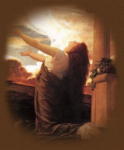 It’s been awhile since writing plainly about the Song of Songs, but lately I’ve been studying it again as much as possible, and honestly, this book never ceases to light a fire in my spiritual life. It’s like nothing else on the planet. :-)
It’s been awhile since writing plainly about the Song of Songs, but lately I’ve been studying it again as much as possible, and honestly, this book never ceases to light a fire in my spiritual life. It’s like nothing else on the planet. :-)
Here’s just a little something to share…(Well, actually it’s a bit lengthy, for those who have a strong appetite)
The Song has three obvious characters: The woman, (the bride or the “Shulamite”) The man, (the bridegroom or “Beloved”) and the Daughters of Jerusalem (younger, less mature friends of the woman). It’s not always clear who is singing what, but they are definitely the primary voices.
But there is one mysterious voice in the middle of the book that is different from the others. It happens right after the provocative text of chapter 4 in which the King is tenderly romancing his Bride, and she is finally receptive to him. Suddenly in the midst of this most sacred moment, a quiet observer appears and shouts out ….
Eat, friends; drink and drink deeply, O lovers! 5:1b
Now just a bit of explanation here, because generally translations do not render the original words of the Song as raw as they really are. The Hebrew in this verse is clearly referring to indulgent intoxication, and that with the joy of intimacy – not with eating and drinking. But the Song isn’t the only place where a metaphor of eating and drinking means something more. Here are just a couple that come to mind:
Behold I stand at the door and knock: if anyone hears my voice and opens the door, I will come in to them, and eat and drink with them, Rev.3:20 (cf. Song 5:2)
Whoever eats my flesh, and drinks my blood, has eternal life, John 6:54
The Importance of Chiasms
Recently I ran across a brief suggestion that this particular verse in the Song is a “chiasm.” (kī-ˌa-zəm) Now I had never heard this term before, but after some research I became very excited! A biblical chiasm, or “chiastic structure,” is a writing style in which there is a thought (encapsulated in a part of a verse, or more than one verse) that is like an intersecting hinge, connecting a progression of thoughts that come before, and a similar progression of thoughts that come after. And generally the thoughts that come after the chiasm are in reverse of the thoughts that come before. So a complete chiastic pattern ends in a very similar way that it begins.
One simple example is Matthew 6:24:
A – No one can serve two masters;
B – for either he will hate the one
C – and love the other,
C – or he will be devoted to one
B – and despise the other.
A – You cannot serve God and wealth.
Notice how the the A, B, and C sections verses are all similar, yet expressed a little different. By recognizing a chiastic pattern, sometimes hidden meanings can be discovered by comparing sections against themselves. And sometimes these patterns are easy to see, but others, like the one in the Song, are bridging a much larger grouping of words and events. Ones that might even have more sub-chiasms tucked inside!
Anyway, it makes sense to me that Song 5:1b is a certain kind of chiasm for the whole book, because of how similar it begins and ends, and also the similar events that happen before and after. “History repeats itself,” so the saying goes, but where it cycles, one can look for both a chiasm and a hope that we are coming back to the very beginning of all history. And what greater chiasm is there than the Cross? It links a grand love story that began in a garden (Genesis 1) and will end in a garden. (Revelation 22) And if that’s not heavy enough, Jesus Christ “drank to the full” a cup of suffering – all in view of sharing, with us, this cup of intoxicating fellowship that is pre-figured in The Song.
“For the joy set before Him, He endured the cross,” Heb. 12:2
That’s all I want to share about chiasms right now. If you are interested in learning more, I recommend this man’s website. He is currently devoting his life to finding all the chiasms in the Bible and it’s very interesting. :-)
An Invitation to Mind-Blowing, Life-Changing Joy!
Back to the verse in The Song. Believing, as I do, that this mysterious voice is God’s voice, (and as such, it is the only direct voice of God in the whole book) what can we learn?
First ~ There is permission and encouragement to abandon fear, inhibition, and self-consciousness. We don’t usually think of ourselves being this way with God, but a “cold heart” is one that has suppressed spiritual emotions because of fear or shame, and a “cold body” (including the spiritual parallel of the body of Christ with each other) is one that struggles to enjoy the warmth of love, and especially the celebratory and blazing joy that comes with oneness. (Either way, it is for “heat” that Christ has set us free) :-)
Second ~ Because of this Voice’s central, chiastic timing, there is an urgency to respond. If you are like me, I feel the Lord taking His bride somewhere new – somewhere she has never been before. Call it a “high calling” if you wish, but heeding this invitation to “drink and drink deeply” is interestingly made to be a pivotal point of partnering with Him in any mature kind of way.
And here it is worded elsewhere….
- I have come that you would have life, and have it more abundantly, John 10:10
- I say these things that your joy would be full, 1 John 1:4
- Rejoice with joy unspeakable, and full of His beauty, 1 Peter 1:8
- Eat and drink deeply of each other, O lovers…Be filled with His Spirit! Song 5:1b & Eph. 5:18
A Prayer: Father, I hear this invitation of yours, which has come at a very important time. Christ has been to me the most kindest of lovers, and I long to enter into that most fruitful place of oneness with Him. I understand the cost to such intimacy is death, therefore I ask that you would show me any dark shadows of fear that is hindering me from deeply drinking with Him, and others, this most precious cup of suffering and ultimate joy. ~ Amen





Recent Comments